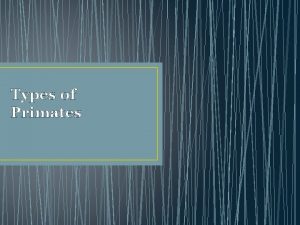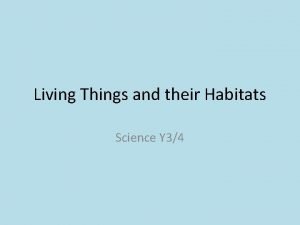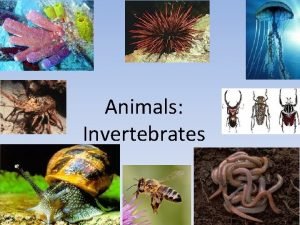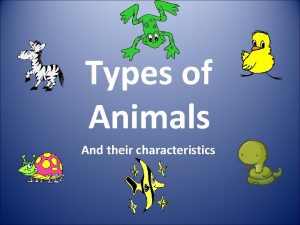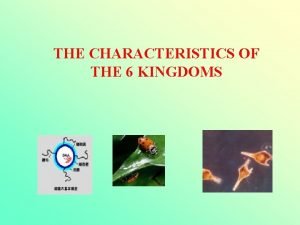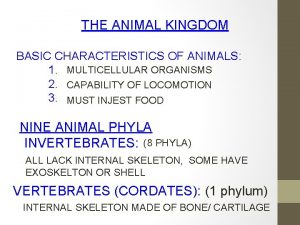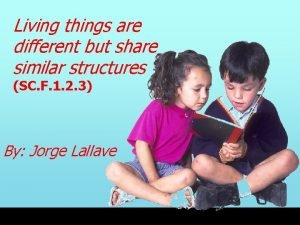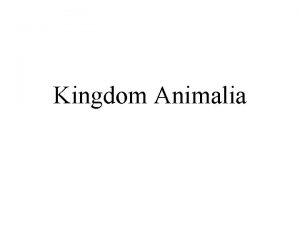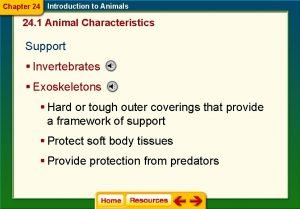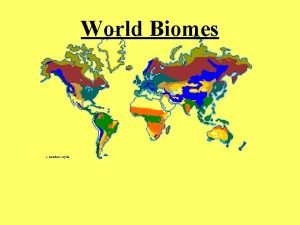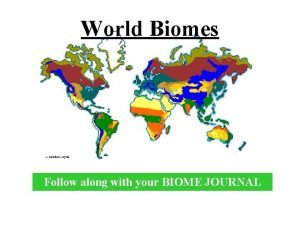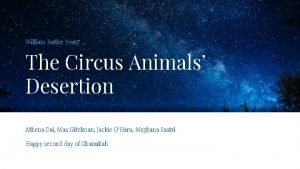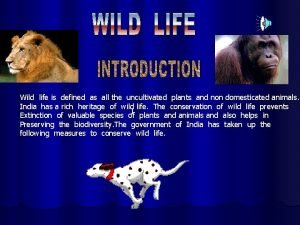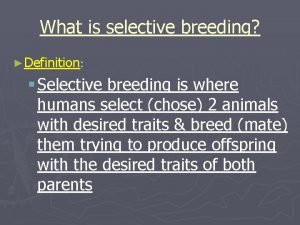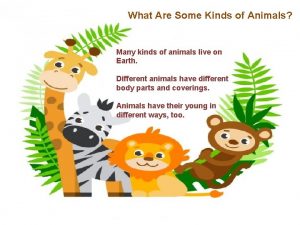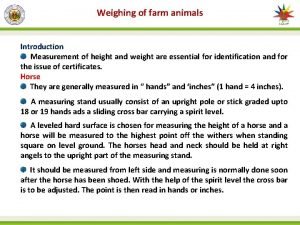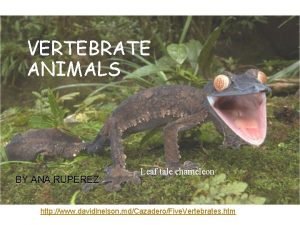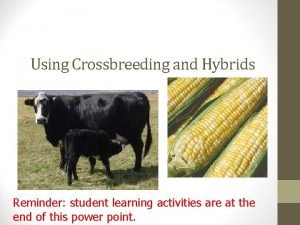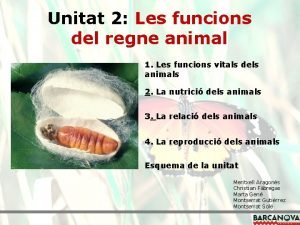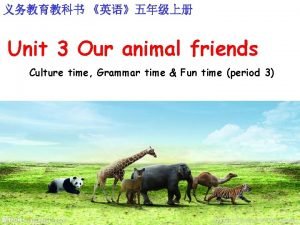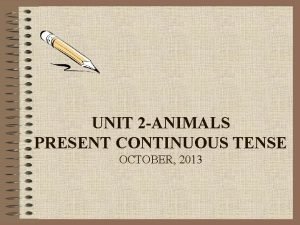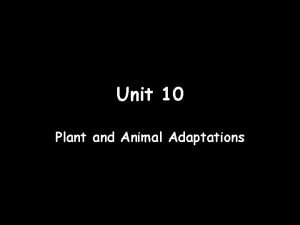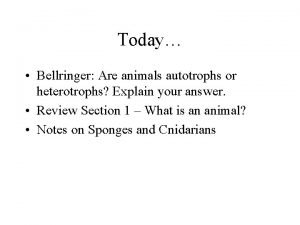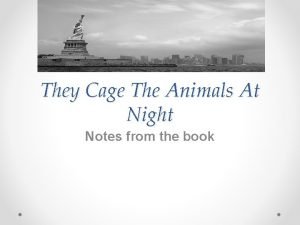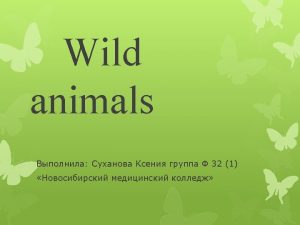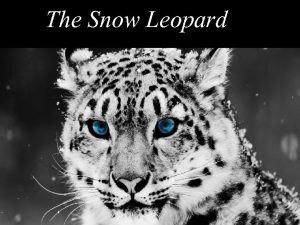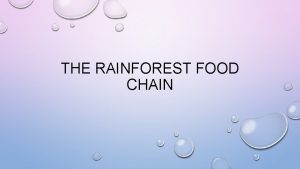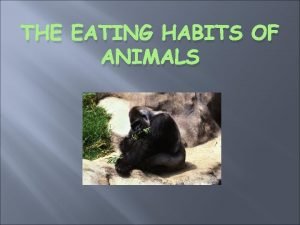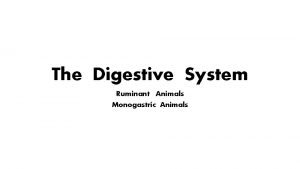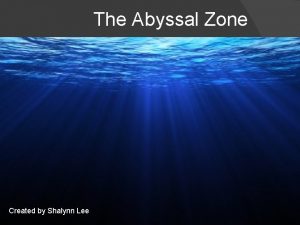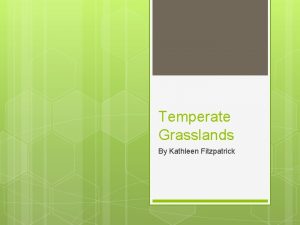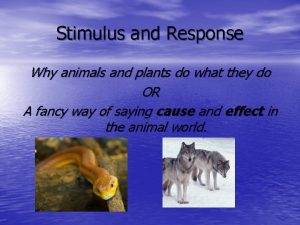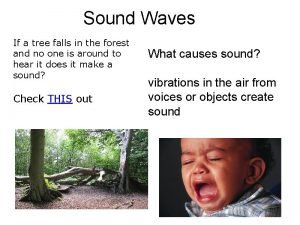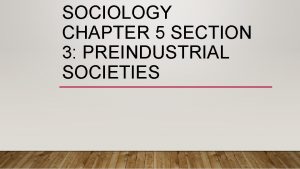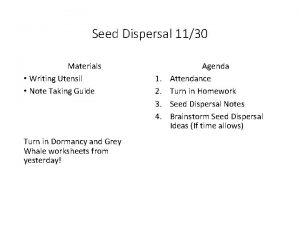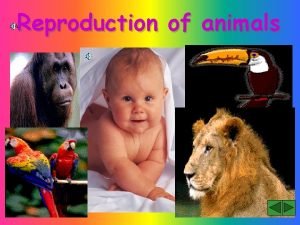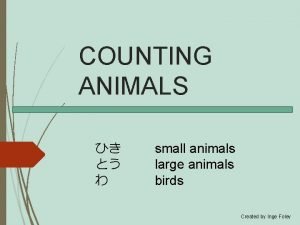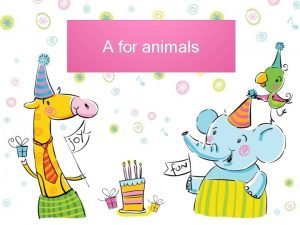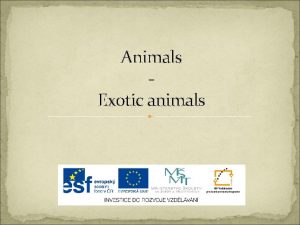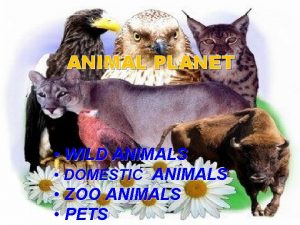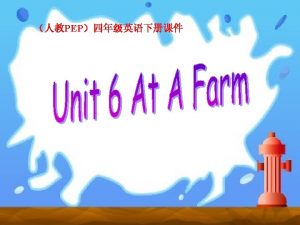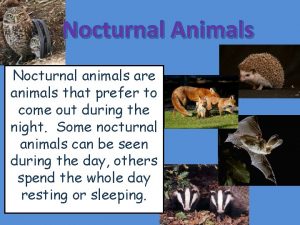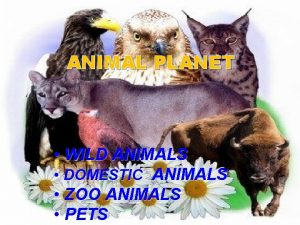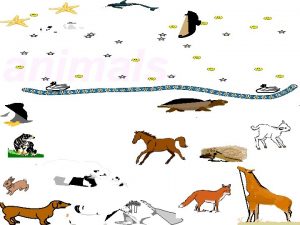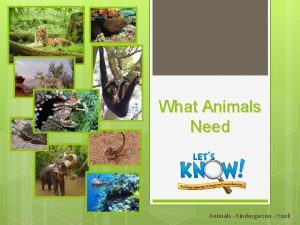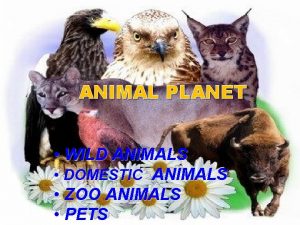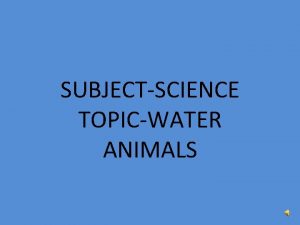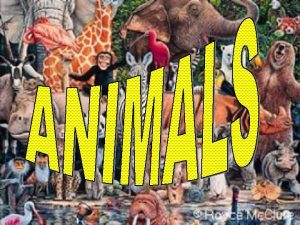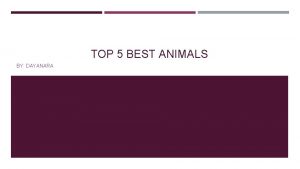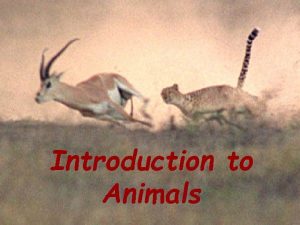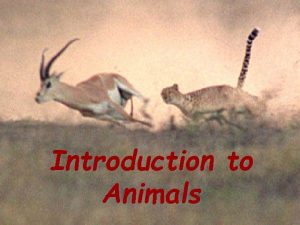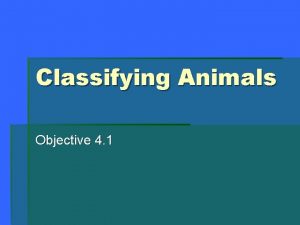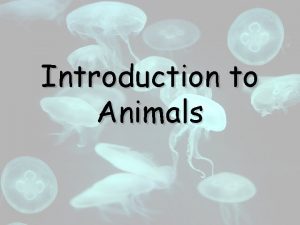CHARACTERISTICS OF ANIMALS Characteristics of Animals What characteristics














































- Slides: 46

CHARACTERISTICS OF ANIMALS

Characteristics of Animals • What characteristics do all animals share? • Animals, which are members of the kingdom ANIMALIA, are: • Multicellular • Heterotrophic • Eukaryotic

Characteristics of Animals – Animals are all heterotrophs; they obtain nutrients and energy by eating other organisms. – Animals are also multicellular; their bodies are composed of many cells. – The cells that make up animal bodies are eukaryotic, containing a nucleus and membrane-bound organelles.

Types of Animals • All animals can be divided into two types: - Invertebrates - Vertebrates (Chordates)

Invertebrates • Invertebrates include all animals that lack a backbone, or vertebral column.

Invertebrates • More than 95 percent of animal species are informally called invertebrates. Invertebrates include at least 33 phyla. • • Invertebrates include: sea stars, worms, jellyfishes, and insects. They range in size from dust mites to giant squid more than 20 meters long.

Vertebrates • All chordates exhibit four characteristics during at least one stage of life: • • a dorsal, hollow nerve cord a notochord a tail that extends beyond the anus pharyngeal pouches.

Vertebrates • Fewer than 5 percent of animal species are chordates.

Needs for Survival

What Animals Do to Survive • Animals must reproduce • Animals must maintain homeostasis by: • responding to information • obtaining and distributing oxygen and nutrients • collecting and eliminating carbon dioxide and other wastes

Maintaining Homeostasis • Often, homeostasis is maintained by feedback inhibition, or negative feedback, a system in which the product or result of a process limits the process itself. • for example, if you get too cold, you shiver, using muscle activity to generate heat • or if you get too hot, you sweat, which helps you lose heat

Responding to Information • The nervous system gathers information using cells called receptors that respond to sound, light, chemicals, and other stimuli.

Responding to Information • Some invertebrates have only a loose network of nerve cells, with no real center. • Other invertebrates and most chordates have large numbers of nerve cells concentrated into a brain. A leech has 32 brains! But not the brains you think of…

Obtaining and Distributing Oxygen and Nutrients • All animals must “breathe” to obtain oxygen. • organ systems • diffusion

Obtaining and Distributing Oxygen and Nutrients • All animals must “eat” to obtain nutrients. • Most animals have a digestive system that acquires food and breaks it down into forms cells can use.

Obtaining and Distributing Oxygen and Nutrients • After acquiring oxygen and nutrients, animals must transport them to cells throughout their bodies by using some kind of circulatory system.

Obtaining and Distributing Oxygen and Nutrients • Open Circulatory System – pump blood into a hemocoel with the blood diffusing back to the circulatory system between cells • Hemocoel - cavity or series of spaces between the organs of most arthropods and mollusks through which the blood circulates • Closed Circulatory System – blood is pumped by a heart through vessels, and does not normally fill body cavities.

Collecting and Eliminating CO 2 and Other Wastes • Animals’ metabolic processes generate carbon dioxide and other waste products, some of which contain nitrogen in the form of ammonia. • Both carbon dioxide and ammonia are toxic in high concentrations and must be excreted, or eliminated from the body.

Reproducing • Most animals reproduce sexually by producing haploid gametes. Reproduction of Various Animals VIDEO

Reproducing • Many invertebrates and a few vertebrates can also reproduce asexually (1 parent). • Asexual reproduction produces offspring that are genetically identical to the parent.

Reproducing • Sexual reproduction (2 parents) helps create and maintain genetic diversity, which increases a species’ ability to evolve and adapt as its environment changes.

Reproducing Terms to know: • Viviparous - Bringing forth live young that have developed inside the body of the parent • Oviparous - Producing young by means of eggs that are hatched after they have been laid by the parent • Ovoviparous - Producing young by means of eggs that are hatched within the body of the parent

ANIMAL BODY PLANS and EVOLUTION

Features of Body Plans • Features of animal body plans include: • • levels of organization body symmetry differentiation of germ layers formation of body cavities patterns of embryological development segmentation cephalization limb formation

Levels of Organization • As the first cells of most animals develop, they differentiate into specialized cells that are organized into tissues. A tissue is a group of cells that perform a similar function.

Levels of Organization • Tissues combine during growth and development to form organs and organ systems that carry out complex functions.

Body Symmetry • The bodies of most animals exhibit some type of symmetry. • Radial • Bilateral • Asymmetrical

Differentiation of Germ Layers • During embryological development, the cells of most animal embryos differentiate into three layers called germ layers. • Endoderm • Mesoderm • Ectoderm

Differentiation of Germ Layers • Cells of the endoderm, or innermost germ layer, develop into the linings of the digestive tract and much of the respiratory system. • Cells of the mesoderm, or middle layer, give rise to muscles and much of the circulatory, reproductive, and excretory organ systems. • The ectoderm, or outermost layer, produces sense organs, nerves, and the outer layer of the skin.

Formation of a Body Cavity • Most animals have some kind of body cavity—a fluidfilled space between the digestive tract and body wall. • A body cavity provides a space in which internal organs can be suspended and room for those organs to grow.

Formation of a Body Cavity • Most complex animal phyla have a true coelom, a body cavity that develops within the mesoderm and is completely lined with tissue derived from mesoderm.

Formation of a Body Cavity • Some invertebrates have only a primitive jellylike layer between the ectoderm and endoderm. • Other invertebrates lack a body cavity altogether, and are called acoelomates.

Formation of a Body Cavity • Still other invertebrate groups have a pseudocoelom, which is only partially lined with mesoderm.

Patterns of Embryological Development • Every animal that reproduces sexually begins life as a zygote, or fertilized egg. • As the zygote begins to develop, it forms a blastula, a hollow ball of cells.

Patterns of Embryological Development • As the blastula develops, it folds in on itself, forming an elongated structure with a tube that runs from one end to the other. This tube becomes the digestive tract.

Patterns of Embryological Development • At first this digestive tract has only a single opening. However, an efficient digestive tract needs two openings.

Patterns of Embryological Development • In phyla that are protostomes, the blastopore becomes the mouth. The anus forms from a second opening. • Most invertebrates are protostomes.

Patterns of Embryological Development • In deuterostomes, the blastopore becomes the anus, and the mouth is formed from a second opening that develops. • Chordates and echinoderms are deuterostomes.


Segmentation: Repeating Parts • As many bilaterally symmetrical animals develop, their bodies become divided into numerous repeated parts, or segments.

Cephalization: Getting a Head • Animals with bilateral symmetry typically exhibit cephalization, the concentration of sense organs and nerve cells at their anterior end. • The most successful animal groups, including arthropods and vertebrates, exhibit cephalization.

Limb Formation: Legs, Flippers, and Wings • Segmented, bilaterally symmetrical animals typically have external appendages on both sides of the body.

Limb Formation: Legs, Flippers, and Wings • These appendages vary from simple groups of bristles in some worms, to jointed legs in spiders, wings in dragonflies, and a wide range of limbs, including bird wings, dolphin flippers, and frog legs.

Body Plans • The body plans of modern invertebrates and chordates suggest evolution from a common ancestor.


 Https://a-z-animals.com
Https://a-z-animals.com Consumer producer decomposer
Consumer producer decomposer G h patel college of engineering and technology
G h patel college of engineering and technology Animals that eat both plants and animals
Animals that eat both plants and animals Characteristics of arboreal animals
Characteristics of arboreal animals 5 classification of vertebrates
5 classification of vertebrates Characteristics of invertebrates
Characteristics of invertebrates Animals and their characteristics
Animals and their characteristics Characteristic of
Characteristic of Characteristics of the animal kingdom
Characteristics of the animal kingdom Characteristics of animals as living things
Characteristics of animals as living things Animalia characteristics
Animalia characteristics Introduction to animals section 1 animal characteristics
Introduction to animals section 1 animal characteristics Bougainvillea tropical rainforest
Bougainvillea tropical rainforest Plant adaptation in temperate forest
Plant adaptation in temperate forest The circus animals desertion
The circus animals desertion Non domesticated animals and uncultivated plant life
Non domesticated animals and uncultivated plant life Why did orwell use animals instead of people
Why did orwell use animals instead of people What animals live in the desert
What animals live in the desert Selective breeding meaning
Selective breeding meaning Two types of animals
Two types of animals Methods of weighing animals
Methods of weighing animals 5 vertebrate animals
5 vertebrate animals Cephalic vein venipuncture
Cephalic vein venipuncture Pebbble go
Pebbble go Example of hybridization in animals
Example of hybridization in animals Esquema regne animal
Esquema regne animal Teamwork animals working together
Teamwork animals working together Present continuous animals
Present continuous animals Adaptation of jellyfish
Adaptation of jellyfish Are sponges autotrophs or heterotrophs
Are sponges autotrophs or heterotrophs They cage the animals at night doggie
They cage the animals at night doggie Two types of animals
Two types of animals Snow leopard niche
Snow leopard niche Food web amazon
Food web amazon Omnivore teeth structure
Omnivore teeth structure Ruminant animals
Ruminant animals Abyssal zone biome
Abyssal zone biome Grassland
Grassland Deciduous forests around the world
Deciduous forests around the world Taxis vs kinesis
Taxis vs kinesis Parasitism'
Parasitism' How animals respond to stimuli
How animals respond to stimuli Echolocation animals
Echolocation animals Describe preindustrial societies of agriculturalists.
Describe preindustrial societies of agriculturalists. Sexual reproduction
Sexual reproduction Seed dispersal by animals worksheet
Seed dispersal by animals worksheet




